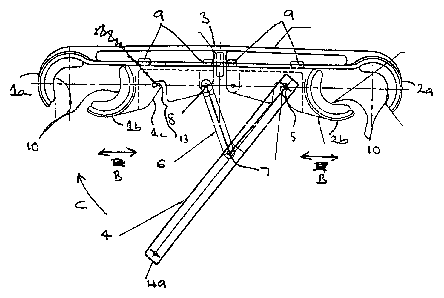Some of the information on this Web page has been provided by external sources. The Government of Canada is not responsible for the accuracy, reliability or currency of the information supplied by external sources. Users wishing to rely upon this information should consult directly with the source of the information. Content provided by external sources is not subject to official languages, privacy and accessibility requirements.
Any discrepancies in the text and image of the Claims and Abstract are due to differing posting times. Text of the Claims and Abstract are posted:
| (12) Patent Application: | (11) CA 2347815 |
|---|---|
| (54) English Title: | LINE SPACER FOR POWER TRANSMISSION LINES |
| (54) French Title: | SEPARATEUR POUR LIGNES DE TRANSMISSION D'ENERGIE ELECTRIQUE |
| Status: | Deemed Abandoned and Beyond the Period of Reinstatement - Pending Response to Notice of Disregarded Communication |
| (51) International Patent Classification (IPC): |
|
|---|---|
| (72) Inventors : |
|
| (73) Owners : |
|
| (71) Applicants : |
|
| (74) Agent: | OSLER, HOSKIN & HARCOURT LLP |
| (74) Associate agent: | |
| (45) Issued: | |
| (86) PCT Filing Date: | 1999-11-02 |
| (87) Open to Public Inspection: | 2000-05-11 |
| Examination requested: | 2004-10-08 |
| Availability of licence: | N/A |
| Dedicated to the Public: | N/A |
| (25) Language of filing: | English |
| Patent Cooperation Treaty (PCT): | Yes |
|---|---|
| (86) PCT Filing Number: | PCT/NZ1999/000180 |
| (87) International Publication Number: | NZ1999000180 |
| (85) National Entry: | 2001-04-24 |
| (30) Application Priority Data: | ||||||
|---|---|---|---|---|---|---|
|
A line spacer for use between power transmission lines to maintain the lines
at a set spacing from each other includes at least two spaced jaws and a lever
action closure mechanism operable to close the jaws after engaging of the
spacer onto adjacent lines, to fix the spacer in position between the lines.
L'invention porte sur un séparateur destiné à être utilisé entre des lignes de transmission d'énergie électrique de façon à maintenir entre ces lignes un espacement défini. Ce séparateur comprend au moins deux mâchoires espacées et un mécanisme de blocage de l'action du levier qui ferme les mâchoires après la pose du séparateur sur des lignes adjacentes afin de le positionner entre les lignes.
Note: Claims are shown in the official language in which they were submitted.
Note: Descriptions are shown in the official language in which they were submitted.

2024-08-01:As part of the Next Generation Patents (NGP) transition, the Canadian Patents Database (CPD) now contains a more detailed Event History, which replicates the Event Log of our new back-office solution.
Please note that "Inactive:" events refers to events no longer in use in our new back-office solution.
For a clearer understanding of the status of the application/patent presented on this page, the site Disclaimer , as well as the definitions for Patent , Event History , Maintenance Fee and Payment History should be consulted.
| Description | Date |
|---|---|
| Application Not Reinstated by Deadline | 2008-11-03 |
| Time Limit for Reversal Expired | 2008-11-03 |
| Deemed Abandoned - Failure to Respond to Maintenance Fee Notice | 2007-11-02 |
| Inactive: Abandoned - No reply to s.30(2) Rules requisition | 2007-10-23 |
| Inactive: S.30(2) Rules - Examiner requisition | 2007-04-23 |
| Letter Sent | 2004-10-26 |
| Request for Examination Received | 2004-10-08 |
| Request for Examination Requirements Determined Compliant | 2004-10-08 |
| All Requirements for Examination Determined Compliant | 2004-10-08 |
| Letter Sent | 2001-12-06 |
| Letter Sent | 2001-12-06 |
| Inactive: Single transfer | 2001-10-26 |
| Inactive: Courtesy letter - Evidence | 2001-09-25 |
| Inactive: Single transfer | 2001-08-03 |
| Inactive: Cover page published | 2001-07-24 |
| Inactive: First IPC assigned | 2001-07-15 |
| Inactive: Courtesy letter - Evidence | 2001-07-10 |
| Inactive: Notice - National entry - No RFE | 2001-07-04 |
| Application Received - PCT | 2001-06-18 |
| Application Published (Open to Public Inspection) | 2000-05-11 |
| Abandonment Date | Reason | Reinstatement Date |
|---|---|---|
| 2007-11-02 |
The last payment was received on 2006-10-20
Note : If the full payment has not been received on or before the date indicated, a further fee may be required which may be one of the following
Patent fees are adjusted on the 1st of January every year. The amounts above are the current amounts if received by December 31 of the current year.
Please refer to the CIPO
Patent Fees
web page to see all current fee amounts.
| Fee Type | Anniversary Year | Due Date | Paid Date |
|---|---|---|---|
| Basic national fee - standard | 2001-04-24 | ||
| Registration of a document | 2001-08-03 | ||
| MF (application, 2nd anniv.) - standard | 02 | 2001-11-02 | 2001-09-27 |
| MF (application, 3rd anniv.) - standard | 03 | 2002-11-04 | 2002-10-01 |
| MF (application, 4th anniv.) - standard | 04 | 2003-11-03 | 2003-09-26 |
| Request for examination - standard | 2004-10-08 | ||
| MF (application, 5th anniv.) - standard | 05 | 2004-11-02 | 2004-10-25 |
| MF (application, 6th anniv.) - standard | 06 | 2005-11-02 | 2005-10-28 |
| MF (application, 7th anniv.) - standard | 07 | 2006-11-02 | 2006-10-20 |
Note: Records showing the ownership history in alphabetical order.
| Current Owners on Record |
|---|
| TYCO ELECTRONICS LOGISTICS AG |
| Past Owners on Record |
|---|
| BRUCE RAYMOND MACKINNON |
| OWEN ROSS GREGORY |